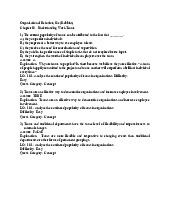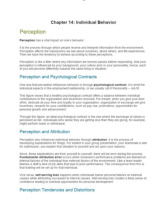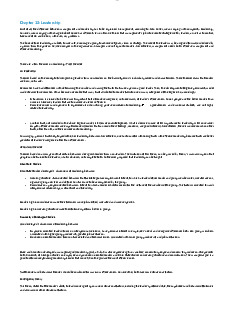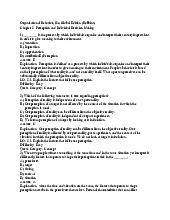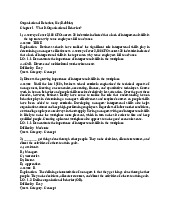














Preview text:
lOMoAR cPSD| 58504431
CHAPTER 2: DIVERSITY IN THE ORGANIZATION
- Intellectual Abilities
The abilities needed to perform mental activities. General Mental Ability (GMA) is a measure of
overall intelligence. No correlation between intelligence and job satisfaction.
Include number aptitude, verbal comprehension, perceptual speed, inductive reasoning,
deductive reasoning, spatial visualization, and Memory (7 dimensions)
+ Number aptitude: khả năng làm số học nhanh chóng và chính xác, hiệu quả trong các công việc đòi
hỏi khả năng toán học (kế toán, kiểm toán, phân tích tài chính)
+ Verbal comprehension: khả năng phân tích từ ngữ, hiểu chín chắn lời nói, ngôn từ, … Hữu ích
trong các công việc mà người quản lý cần hiểu rõ các chính sách để thực hiện nhiệm vụ công việc của
họ + Perceptual speed: xác định những điểm tương đồng và khác biệt nhanh chóng và chính xác.
Hữu ích khi một nhân viên cần tiếp nhận nhiều thông tin và đưa ra quyết định (thám tử, thanh tra, …)
+ Inductive reasoning: Khả năng xác định một trình tự hợp lý trong một vấn đề để giúp tìm ra giải pháp.
+ Deductive reasoning: khả năng sử dụng logic và đánh giá hàm ý của lập luận
+ Spatial visualization: khả năng tưởng tượng về hình học, không gian, … Vd: thiết kế nội thất, … +
Memory: khả năng ghi nhớ, và nhớ lại những kinh nghiệm trong quá khứ.
- Physical Abilities: The capacity to do tasks demanding stamina, dexterity, strength, and similar characteristics. DIVERSITY MANAGEMENT
- Must be an ongoing commitment at all levels of the organization.
- Policies must include multiple perspectives and be long term in their orientation to be effective.
CHAPTER 3: ATTITUDE AND JOB SATISFACTION Three components of an
attitude: Cognitive: The opinion or belief of an attitude
Affective: The emotional or feeling of an attitude
Behavioral: An intention to behave in a certain way
Trình tự: My pay is very low (Cognitive). I’m angry over how little I am paid (Affective). Hence, I’m
going to look for another jobs that pays better. (Behavioral)
COGNITIVE DISSONANCE: bất hòa trong nhận thức, xảy ra khi chúng ta có một sự nhận thức
khác biệt vs niềm tin, những nhận định trước đó => căng thẳng về mặt tâm lí.
- The most powerful moderators of the attitude-behavior relationship are:
+ Importance of the attitude: how strong your attitude is lOMoAR cPSD| 58504431
+ Correspondence to behavior. How related are your attitude and behavior (Thái độ và hành vi càng
cụ thể thì mối liên kết giữa chúng càng mạnh hơn)
+ Accessibility: How easy or available for you to behave as you intended (Ex: Trong công ty có 1
chuyên gia tư vấn tài chính. Quản lí rất muốn mời ông ta để lập bảng kế hoạc tài chính. Tuy nhiên, bạn
không đủ kinh phí để mời ông ta để làm việc này => bạn phải tự làm nó một mình).
+ Existence of social pressures
+ Personal and direct experience of the attitude: kinh nghiệm trong quá khứ có thể sẽ ảnh hưởng tới attitude và hành vi.
Organizational Commitment (lời cam kết)
+ Identifying with a particular organization and its goals, while wishing to maintain membership in the organization. + Three dimensions:
• Affective – emotional attachment to organization
• Continuance Commitment – economic value of staying
• Normative – moral or ethical obligations (Ex: when in relationship with other, feel morality.
Some people feel comfortable, some is sick, …)
Outcome of job satisfaction: Better and more productive in Job Performance, better OCB through
the fairness, Better Satisfied customer -> More loyalty, Less absenteeism
CHAPTER 4: EMOTION AND MOOD General information
-Emotions were seen as irrational. Managers worked to make emotion-free environments lOMoAR cPSD| 58504431 -View of Emotionality
+ Emotions were believed to be disruptive
+ Emotions interfered with productivity
+ Only negative emotions were observed
emotions can’t be separated from the workplace Mood (Tâm trạng) Emotion (Cảm xúc) - Less intense - More intense
- Basic Moods: Positive and Negative
- Basic Emotions: Happiness – surprise – Affect
fear – sadness – anger – disgust
Emotions are necessary for rational decisions.
(đưa ra quyết định dựa vào lý trí)
Sources of Emotion and Mood
Personality: There is a trait component – affect intensity Day and Time of the Week:
Happier in the midpoint of the daily awake period
Happier toward the end of the week
Weather: Illusory correlation – NO EFFECT
Stress: Even low levels of constant stress can worsen moods
Social Activities: Physical, informal, and dining activities increase positive moods Other factors:
Sleep: Poor sleep quality increases negative affect
Exercise: Does somewhat improve mood, especially for depressed people
Age: Older folks experience fewer negative emotions Gender
– Women tend to be more emotionally expressive, feel emotions more intensely, have
longer-lasting moods, and express emotions more frequently than do men
– Due more to socialization than to biology
AET has a number of implications. These implications are as follows:
1. When an employee has an emotional episode, it is actually the result of a series of emotional
experiences that are triggered by a single event.
2. Your job satisfaction is impacted by current and past emotions.
3. As your emotions fluctuate over time, it will create variations in job performance. lOMoAR cPSD| 58504431
4. Behaviors that are driven by emotions are typically brief and variable.
5. Both positive and negative emotions can distract workers and reduce job performance.
CHAPTER 5: PERSONALITY AND VALUES
PERSONALITY is often defined by characteristics such as outgoing or charming. However,
psychologists define personality as the growth and development of a person’s whole psychological system.
- Personality Test: MBTI và BIG FIVE MODEL
(MBTI test tương tự như trong Principle of Management)
+ Big Five Model: O.C.E.A.N
O: Openness to the Experience
C: Conscientiousness (sự tận tâm)- responsible, dependable and organized
E: Extroversion (hướng ngoại)- Sociable, gregarious, assertive
A: Agreeableness (dễ chịu)- good- natured, cooperative, trusting, …
E: Emotional Stability (tính ổn định của cảm xúc): calm, self- confident, depressed, insecure under stress, …
BIG FIVE MODEL is better for work than MBTI test.
• Highly conscientious people develop more job knowledge, exert greater effort, and have better performance.
• Emotional stability is related to job satisfaction.
• Extroverts tend to be happier in their jobs and have good social skills.
• Open people are more creative and can be good leaders.
• Agreeable people are good in social settings.
Core Self-Evaluation: The degree to which people like or dislike themselves. Positive selfevaluation
leads to higher job performance
Machiavellianism: A pragmatic, emotionally distant power-player who believes that ends justify the
means. Have the successful when: Have direct interaction
Work with minimal rules and regulations Emotions distract others
Narcissism (tự kiêu): An arrogant, entitled, self-important person who needs excessive admiration Less effective in their jobs
Self-Monitoring: The ability to adjust behavior to meet external, situational factors. High monitors
conform more and are more likely to become leaders. lOMoAR cPSD| 58504431
Risk Taking: The willingness to take chances. May be best to align propensities with job
requirements. Risk takers make faster decisions with less information.
Type A Personality: Aggressively involved in a chronic, incessant struggle to achieve more in less time
• Impatient: always moving, walking, and eating rapidly
• Strive to think or do two or more things at once
• Cannot cope with leisure time
• Obsessed with achievement numbers
Type B ngược hoàn toàn với Type A => suy ngược ra dễ dàng
Proactive Personality: Identifies opportunities, shows initiative, takes action, and perseveres to
completion. Creates positive change in the environment (Tính cách TỰ THÂN VẬN ĐỘNG) PART B: VALUES
Values represent basic convictions that make judgments about what is the best mode of conduct or end-state of existence.
Hofstede’s Framework: Power Distance -
Low distance: Relatively equal power between those with status/wealth and those without status/wealth lOMoAR cPSD| 58504431 -
High distance: Extremely unequal power distribution between those with status/wealth and those without status/wealth
Hofstede’s Framework: Individualism
Individualism: The degree to which people prefer to act as individuals rather than as member
of groups (chủ nghĩa cá nhân: đặt vấn đề, tâm tư nguyện vọng của bản thân lên trên hết. Tuy
nhiên, chủ nghĩa cá nhân liệu có phải THỰC SỰ LÀ XẤU?)
Collectivism: A tight social framework in which people expect others in groups of which they
are a part to look after them and protect them (Mỗi cá nhân mong muốn có được sự bảo hộ, hỗ
trợ đến từ một tập thể- tổ chức nào đó)
Masculinity: The extent to which the society values work roles of achievement, power, and
control, and where assertiveness and materialism are also valued
Femininity: The extent to which there is little differentiation between roles for men and women
Hofstede’s Framework: Uncertainty Avoidance
High Uncertainty Avoidance: Society does not like ambiguous situations and tries to avoid them.
Low Uncertainty Avoidance: Society does not mind ambiguous situations and embraces them.
Hofstede’s Framework: Time Orientation
Long-term Orientation A national culture attribute that emphasizes the future, thrift, and persistence
Short-term Orientation: A national culture attribute that emphasizes the present and the here and now
CHAPTER 6: PERCEPTION NAD INDIVIDUAL DECISION MAKING
Perception: A process by which individuals organize and interpret their sensory impressions in order
to give meaning to their environment. (Nhận thức) Factors of perception:
+ Factor in the perceiver: Attitudes, Mood, Experience, Expectation, … (Khi một cá nhân nhìn nhận
một vấn đề, sự diễn giải đó sẽ chịu ảnh hưởng nặng nề đến từ những đặc điểm cá nhân. Vd: 1 người
có kiến thức về âm nhạc, khi nghe nhạc giao hưởng => cảm nhận được cái hay của nó. Điều ngược
lại, một người không có kiến thức âm nhạc => không thấy nhạc giao hưởng hay, rất dở, …)
+ Factors in the target: Novelty, motion, Sounds, Size, background, proximity, similarity
Vd: Một người sôi nổi sẽ được chú ý nhiều hơn trong một tổ chức, những vật được sắp xếp gấn nhau
thường có xu hướng được nhận thức, đánh giá như nhau, … + Factor in the situation: Time, work setting, social setting
Vd: Mặc đồ formal (quần tây, áo sơ mi) nhưng đi vào bar paylak => đánh giá hư hỏng, không tốt lOMoAR cPSD| 58504431
Ngược lại, cũng đồ formal nhưng khi đi vào trường học, cơ quan => được đánh giá tốt, con ngoan trò giỏi, …
Attribution Theory: Judging Others
-Our perception and judgment of others is significantly influenced by our assumptions of the other person’s internal state
Errors and biases in attribution
Fundamental Attribution Error: underestimate external factors, overestimate the internal
factors. (We blame people first, not the situation)
Self-Serving Bias: attribute own successes to internal factors, blame for failures on external
factors (It is “our” success but “their” failure) Frequently used shortcut in judging others
Selective Perception: People selectively interpret what they see on the basis of their
interests, background, experience, and attitudes (chỉ nhìn thứ mà mình thích, không để ý
đến những yếu tố khác)
Halo Effect: Drawing a general impression about an individual on the basis of a single
characteristic (Hiệu ứng hào quang. Vd: trong một tổ chức, mọi người chỉ thấy A đi làm đúng
giờ, năng suất công việc ổn định => mọi người trong công ty cho rằng A là một người tốt). Trái
ngược với Halo Effect là Horn effect
Contrast Effects: Evaluation of a person’s characteristics that are affected by comparisons
with other people recently encountered who rank higher or lower on the same characteristics
(vd: hiện tượng con nhà người ta)
Stereotyping making generalizations about an individual based on the group to which that
person belongs. Useful in making decision, however, it can also be inaccurate and cause us to
mistakenly develop a perception about an individual that is not representative of who they are.
Profiling is an application of stereotyping where members of a group are singled out for
scrutiny based on a single trait. lOMoAR cPSD| 58504431
Problem: A perceived discrepancy between the current state of affairs and a desired state
Decisions: Choices made from among alternatives developed from data
Rational Decision Making: assumes complete information, all options known, and maximum payoff
+ Step 1: Defining the Problems
+ Step 2: Identify the decision criteria (determines what is relevant in making decision)
+ Step 3: Weight the previously identified criteria
+ Step 4: Generate possible alternatives
+ Step 5: Ration each alterative on each criterion
+ Step 6: Computing the optimal decision
Bounded Reality: The “real world” model- seeks satisfactory and sufficient solutions from
limited data and alternatives
Intuition: Relies on holistic associations, affectively charged – engaging the emotions (Đưa ra
quyết định dựa vào trực giác -> result in the quick decision
Common Biases and Errors in Decision Making Overconfidence Bias
Believe too much in your own ability to make good decisions
make decisions outside of their area of expertise
instead of getting other, more knowledgeable Anchoring Bias
Using early, first received information as the basis for
making subsequent judgments Confirmation Bias
Selecting and using only facts that support our decision Availability Bias
Emphasizing information that is most readily at hand
Escalation of commitment Increasing commitment to a decision in spite of evidence that it is wrong Randomness Error
Creating meaning out of random events Winner’s Curse Hindsight Bias
After an outcome is already known, believing it could have
been accurately predicted beforehand lOMoAR cPSD| 58504431
CHAPTER 7: MOTIVATION CONCEPTS
Definition: Motivation is the processes that account for an individual’s intensity, direction, and
persistence of effort toward attaining a goal – specifically, an organizational goal.
+ Intensity – how hard a person tries
+ Direction – effort that is channeled toward, and consistent with, organizational goals
+ Persistence – how long a person can maintain effort
Tháp Maslow: 5 level, thỏa mãn từng bậc rồi mới đến level tiếp theo:
o Physiological: hunger, thirst, shelter, sex and other bodily needs o Safety: security and
protection from physical and emotional harm o Social: affection, belongingness, acceptance, friendship, …
o Esteem: internal esteem factors, self- respect, autonomy (quyền được tự trị), or external
factors such as the attention, the recognition from other people, … o Self – actualization
Theory X and Y: managers used a set of assumption based on their view Theory X Theory Y
Workers have little ambition
Workers are self – directed Dislike work Enjoy work Avoid responsibility Accept responsibility lOMoAR cPSD| 58504431
No empirical evidence to support this theory
Herzberg’s two- factor theory: Satisfaction and dissatisfaction are not opposites but separate constructs Extrinsic Hygiene Intrinsic Related to Factors Motivators Related to Dissatisfaction Satisfaction Company ( nhân tố duy trì , Growth nh ( ân tố động Policies xuất phát từ các viên, xuất phát từ
yếu tố bên ngoài Salary Responsibility
nội tại của nhân của nhân viên) viên) Work Achievement Conditions
Hygiene Factor is the necessary for reduce the dissatisfaction, and the Motivators factors is the
condition to engage the employee’s productivity
Herzberg is limited by his methodology: Participants had self-serving bias
Reliability of raters questioned: Bias or errors of observation
No overall measure of satisfaction was used
Herzberg assumed, but didn’t research, a strong relationship between satisfaction and productivity
McClelland’s Three Needs Theory
Need for Achievement (nAch) The drive to excel, to achieve in relation to a set of
standards, to strive to succeed (Nhu cầu của sự thành công. Họ không theo đuổi quyền lực
hoặc tán dương mà là sự thành công. Họ muốn những công việc vừa phải, xác suất thành
công 50/50. Quản lí có thể giao những công việc nào không quá khó cũng không được quá dễ,
possible target and usually response about their working process)
Need for Power (nPow): The need to make others behave in a way that they would not have
behaved otherwise (Nhu cầu của quyền lực. Họ muốn có được quyền lực trong tay, muốn được
quản lí => consider về việc cho họ làm các manager hoặc leader)
Need for Affiliation (nAff): The desire for friendly and close interpersonal relationships (Nhu
cầu được liên kết- thích các mối quan hệ thân thiện, tránh xung đột, hi sinh lợi ích cá nhân vì
cả nhóm. Mangers should provide them with the friendly- working environment)
CONTEMPORARY THEORIES OF MOTIVATION lOMoAR cPSD| 58504431
Self-Determination Theory: people prefer to have control over their actions. So, when they
are required to do something they previously freely chose, it will diminish their motivation.
– Intrinsic and extrinsic rewards are not independent. Instead, extrinsic rewards may decrease intrinsic rewards
– Goal setting is more effective in improving motivation
– Verbal rewards increase intrinsic motivation; tangible rewards reduce it
Goal-Setting Theory: Management by Objectives (MBO) (Manager set a goal which is
targetable, verifiable and measureable. Workers should accomplish that goal to increase the
organizational productivity)
Self-Efficacy Theory: Also known as Social Cognitive Theory or Social Learning Theory. It
is is based on an individual’s belief that he or she is capable of performing a task Increased Confidence Given the Higher Performance hard Goal
Higher Self - Set Goal
Reinforcement Theory: Khi muốn motivate thì phải reforcement => powerful predictor in many work areas
– Behavior is environmentally caused
– Thought (internal cognitive event) is not important (feelings, attitudes and expectations are ignored)
– Behavior is controlled by its consequences – reinforcers
– Is not a motivational theory but a means of analysis of behavior
– Reinforcement strongly influences behavior but is not likely to be the sole cause
Vd: Đi học sớm thì sẽ được bonus, trong lớp phát biểu nhiều thì sẽ không phải chọn bài tập khó, điểm thấp, …
Equity Theory: Employees compare their ratios of outcomes-to-inputs of relevant others.
+ Employee behaviors to create equity: – Change inputs (slack off)
– Change outcomes (increase output)
– Distort/change perceptions of self lOMoAR cPSD| 58504431
– Distort/change perceptions of others
– Choose a different referent person
– Leave the field (quit the job)
+ Propositions relating to inequitable pay: – Paid by time:
Overrewarded employees produce more
Underrewarded employees produce less with low quality – Paid by quality:
Overrewarded employees give higher quality
Underrewarded employees make more of low quality
Expectancy Theory: The most commonly used and widely accepted. The strength of a
tendency to act in a certain way is dependent on the strength of the expectation that they will
receive a given outcome and that the outcome is desired.
CHAPTER 8: FROM CONCEPT TO APPLICATION
1. The Job Characteristics Model
a. Skill Variety: degree to which the job incorporates a number of different skills and talents
b. Task Identity: degree to which the job requires the completion of a whole and identifiable piece of work
c. Task Significance: how the job impacts the lives of others
d. Autonomy: identifies how much freedom and independence the worker has over the job
e. Feedback: how much the job generates direct and clear information about the worker’s performance
• Job Rotation: The shifting of an employee from one task to another with similar skill requirements.
• Job Enrichment: The expansion of a job by increasing the degree to which the worker
controls the planning, execution, and evaluation of the work. lOMoAR cPSD| 58504431 Helps managers Reduces in scheduling boredom
THE STRENGTH OF JOB ROTATION Increases understanding Increased skills of work contribution Combine Tasks Form Natural Work Units
- > THE POSSIBLE ACTION OF JOB Establish Client Relations ENRICHMENT Expand Jobs Vertically Open Feedback Channels
2. Alternative Work Arrangements
Flextime: Flextime allows employees to choose the hours they work within a defined period of time.
Ex: The worker needs to work 8 hours a day, the manager may say that you can choose 8 hours between 6am and 8pm
Job Sharing: Job Sharing allows two or more individuals to split a traditional 40-hour-aweek job.
Ex: For one project, one worker has to work 20 hours to finish. Now, if there are 1 more employee,
the duration of this project will be decreased.
Telecommuting: Telecommuting allows workers to work from home at least 2 days a week
on a computer linked to the employer’s office.
Ex: Làm việc từ xa từ 2 đến 3 ngày, sau đó làm tại office 3-4 ngày => giúp giảm chi phí của văn
phòng, giảm thiểu các vấn đề liên quan đến di chuyển, nhà tuyển dụng sẽ có nhiều lựa chọn hơn,…
nhưng họ sẽ có ít quyền kiểm soát khi làm việc trực tiếp. Một số nhân viên không làm việc đúng năng suất của họ, …
3. Social and Physical Context of Work lOMoAR cPSD| 58504431
- Social Context: Some social characteristics that improve job performance include:
Interdependence, Social support and Interactions with other people outside of work
- Physical Context: The work context will also affect employee satisfaction Ex: Work that is
hot, loud, and dangerous is less satisfying. Work that is controlled, relatively quiet, and safe
will be more satisfying
- Employee Involvement: A participative process that uses employees’ input to increase their
commitment to the organization’s success. 4. Using Rewards to Motivate Employees
a) Establishing a Pay Structure + Internal Equity + External Equity
b) Variable Pay Program
*Piece-Rate Pay: Pays a fixed sum of money for each unit of production completed. (Trả tiền
lương theo sản phẩm)
For example: Ballpark workers selling peanuts and soda get $1 for each bag of peanuts and soda sold.
*Merit-Based Pay: Pays for individual performance based on performance appraisal results.
If appraisals are designed correctly, workers performing at a high level will get more pay.
*Bonuses: Pay a lump sum at the end of a designated period of time based on individual and/or
organizational performance (tiền thưởng Vd: thưởng cho việc gia nhập công ty, tiền thưởng vì đã
vực dậy được một công ty, …)
*Skill-Based Pay: Pays based on the number of skills employees have or the number of jobs
they can do. (Trả tiền lương theo số lượng skill mà họ cần có để giải quyết sản phẩm)
*Profit-Sharing Plans: Pays out a portion of the organization’s profitability. It is an
organization-wide program and is based on a predetermined formula. (chia cho nhân viện một
phần lợi nhuận của công ty)
*Gainsharing: Pays for improvements in group productivity from one period to another. It is
a group incentive plan (trả thêm tiền cho nhân viên khi năng suất làm việc của họ tăng dần theo từng giai đoạn)
*Employee Stock Ownership Plans (ESOP): Provides each employee with the opportunity to
acquire stock as part of their benefit package (thưởng cho nhân viên không phải bằng tiền mà bằng
cố phiếu của công ty)
Flexible Benefits: give individual rewards by allowing each employee to choose the compensation
package that best satisfies his or her current needs and situations.
More information in this chapter: A method of motivation that has been highly successful is employee
recognition programs. This idea recognizes the importance of coupling extrinsic and intrinsic lOMoAR cPSD| 58504431
methods to help motivate employees. Recognition is an intrinsic motivation technique that can range
from giving an employee the proverbial pat on the back to a more public recognition ceremony.
Recognition programs are highly effective and cost very little to administer. Note:
Extrinsic motivation occurs when we are motivated to perform a behavior or engage in an activity to
earn a reward or avoid punishment. (Động lực bên ngoài xảy ra khi chúng ta được thúc đẩy để thực hiện một
hành vi hoặc tham gia vào một hoạt động để kiếm phần thưởng hoặc tránh bị trừng phạt.) • Vd:
Học vì bạn muốn đạt điểm cao
Dọn phòng của bạn để tránh bị cha mẹ khiển trách Tham
gia một môn thể thao để giành giải thưởng
Mọi người đang tham gia vào một hành vi không phải vì họ thích nó hoặc bởi vì họ nhận lại được gì đó
Intrinsic motivation involves engaging in a behavior because it is personally rewarding; essentially,
performing an activity for its own sake rather than the desire for some external reward. (Động lực nội
tại liên quan đến việc tham gia vào một hành vi bởi vì nó là phần thưởng cá nhân; về cơ bản, thực hiện
một hoạt động vì lợi ích riêng của nó) •
Tham gia một môn thể thao vì bạn thấy hoạt động ấy thú vị •
Chơi trò chơi vì bạn thấy nó thú vị
Về cơ bản, bản thân hành vi là phần thưởng của chính nó.
